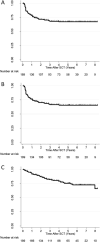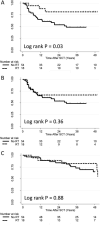A multi-institutional analysis of peritransplantation radiotherapy in patients with relapsed/refractory Hodgkin lymphoma undergoing autologous stem cell transplantation - PubMed (original) (raw)
Multicenter Study
. 2017 Apr 15;123(8):1363-1371.
doi: 10.1002/cncr.30482. Epub 2016 Dec 16.
Shekeab Jauhari 2, John P Plastaras 3, Yago Nieto 4, Bouthaina S Dabaja 1, Chelsea C Pinnix 1, Grace L Smith 1, Pamela K Allen 1, J Nicholas Lukens 3, Amit Maity 3, Yasuhiro Oki 5, Michelle A Fanale 5, Sunita D Nasta 2
Affiliations
- PMID: 27984652
- PMCID: PMC5811230
- DOI: 10.1002/cncr.30482
Multicenter Study
A multi-institutional analysis of peritransplantation radiotherapy in patients with relapsed/refractory Hodgkin lymphoma undergoing autologous stem cell transplantation
Sarah A Milgrom et al. Cancer. 2017.
Abstract
Background: No consensus exists regarding the use of radiotherapy (RT) in conjunction with high-dose chemotherapy and autologous stem cell transplantation (HDC/ASCT) for patients with relapsed/refractory classical Hodgkin lymphoma (HL). The objectives of the current study were to characterize practice patterns and assess the efficacy and toxicity of RT at 2 major transplantation centers.
Methods: Eligible patients underwent HDC/ASCT from 2006 through 2015 using the combination of either carmustine (BCNU), etoposide, cytarabine, and melphalan (BEAM) or cyclophosphamide, BCNU, and etoposide (CBV).
Results: For the cohort of 189 patients, the 4-year overall survival rate was 80%, the progression-free survival rate was 67%, and the local control (LC) rate was 68%. RT was used within 4 months of ASCT for 22 patients (12%) and was given more often for disease that was early stage, primary refractory, or [18 F]fluorodeoxyglucose (FDG)-avid at the time of HDC/ASCT. Disease recurrence occurring after HDC/ASCT was associated with primary refractory disease and FDG-avidity at the time of HDC/ASCT. RT was not found to be associated with LC, progression-free survival, or overall survival on univariate analysis. In a model incorporating primary refractory HL and FDG-avid disease at the time of HDC/ASCT, RT was found to be associated with a decreased risk of local disease recurrence (hazard ratio, 0.3; P = .02). In patients with primary refractory HL and/or FDG-avid disease at the time of HDC/ASCT, the 4-year LC rate was 81% with RT versus 49% without RT (P = .03). There was one case of Common Terminology Criteria for Adverse Events grade ≥ 3 RT-related toxicity (acute grade 3 pancytopenia).
Conclusions: In patients undergoing ASCT for relapsed/refractory HL, peritransplantation RT was used more often for disease that was early stage, primary refractory, or FDG-avid after salvage conventional-dose chemotherapy. RT was associated with improved LC of high-risk localized disease and was well tolerated with modern techniques. Cancer 2017;123:1363-1371. © 2016 American Cancer Society.
Keywords: Hodgkin lymphoma; lymphoma; radiotherapy (RT); stem cell transplantation (SCT).
© 2016 American Cancer Society.
Conflict of interest statement
CONFLICT OF INTEREST DISCLOSURES
The authors made no disclosures.
Figures
Figure 1
Flow diagram summarizing the study cohort. ASCT indicates autologous stem cell transplantation; BEAM, carmustine (BCNU), etoposide, cytarabine, and melphalan; CBV, cyclophosphamide, carmustine (BCNU), and etoposide; HDC, high-dose chemotherapy; HL, Hodgkin lymphoma; RT, radiotherapy.
Figure 2
(A) Local control, (B) progression-free survival, and (C) overall survival for the total cohort (189 patients). SCT indicates stem cell transplantation.
Figure 3
(A) Local control, (B) progression-free survival, and (C) overall survival in the subset of patients with primary refractory Hodgkin lymphoma and/or active (FDG-avid) disease at the time of high-dose chemotherapy/autologous stem cell transplantation (72 patients). Dotted line indicates receipt of peritransplantation radiotherapy (RT); solid line, did not receive peritransplantation RT. SCT indicates stem cell transplantation.
Similar articles
- High-dose chemotherapy and autologous stem cell transplantation for relapsed or refractory nodular lymphocyte predominant Hodgkin lymphoma.
Akhtar S, Elhassan TAM, Edesa W, Rauf MS, Zahir MN, Maghfoor I. Akhtar S, et al. Ann Hematol. 2016 Jan;95(1):49-54. doi: 10.1007/s00277-015-2527-4. Ann Hematol. 2016. PMID: 26467917 - Pre-transplant FDG-PET-based survival model in relapsed and refractory Hodgkin's lymphoma: outcome after high-dose chemotherapy and auto-SCT.
Akhtar S, Al-Sugair AS, Abouzied M, Alkadhi Y, Dingle M, Abdelsalam M, Soudy H, Darwish A, Eltigani A, Elhassan TA, Nabil-Ahmed M, Maghfoor I. Akhtar S, et al. Bone Marrow Transplant. 2013 Nov;48(12):1530-6. doi: 10.1038/bmt.2013.88. Epub 2013 Jun 10. Bone Marrow Transplant. 2013. PMID: 23749108 - Outcome analysis of high-dose chemotherapy and autologous stem cell transplantation in adolescent and young adults with relapsed or refractory Hodgkin lymphoma.
Akhtar S, Rauf SM, Elhassan TA, Maghfoor I. Akhtar S, et al. Ann Hematol. 2016 Sep;95(9):1521-35. doi: 10.1007/s00277-016-2736-5. Epub 2016 Jul 4. Ann Hematol. 2016. PMID: 27376363 - Novel regimens prior to autologous stem cell transplantation for the management of adults with relapsed/refractory non-Hodgkin lymphoma and Hodgkin lymphoma: alternatives to BEAM conditioning.
Isidori A, Christofides A, Visani G. Isidori A, et al. Leuk Lymphoma. 2016 Nov;57(11):2499-509. doi: 10.1080/10428194.2016.1185785. Epub 2016 May 31. Leuk Lymphoma. 2016. PMID: 27243412 Review. - High-dose chemotherapy followed by autologous stem cell transplantation for patients with relapsed/refractory Hodgkin lymphoma.
Rancea M, Monsef I, von Tresckow B, Engert A, Skoetz N. Rancea M, et al. Cochrane Database Syst Rev. 2013 Jun 20;2013(6):CD009411. doi: 10.1002/14651858.CD009411.pub2. Cochrane Database Syst Rev. 2013. PMID: 23784872 Free PMC article. Review.
Cited by
- Novel Salvage Therapy Options for Initial Treatment of Relapsed/Refractory Classical Hodgkin's Lymphoma: So Many Options, How to Choose?
Takiar R, Karimi Y. Takiar R, et al. Cancers (Basel). 2022 Jul 20;14(14):3526. doi: 10.3390/cancers14143526. Cancers (Basel). 2022. PMID: 35884585 Free PMC article. Review. - Risk and Response Adapted Treatment Guidelines for Managing First Relapsed and Refractory Classical Hodgkin Lymphoma in Children and Young People. Recommendations from the EuroNet Pediatric Hodgkin Lymphoma Group.
Daw S, Hasenclever D, Mascarin M, Fernández-Teijeiro A, Balwierz W, Beishuizen A, Burnelli R, Cepelova M, Claviez A, Dieckmann K, Landman-Parker J, Kluge R, Körholz D, Mauz-Körholz C, Wallace WH, Leblanc T. Daw S, et al. Hemasphere. 2020 Jan 10;4(1):e329. doi: 10.1097/HS9.0000000000000329. eCollection 2020 Feb. Hemasphere. 2020. PMID: 32072145 Free PMC article. Review. - Patterns of Relapse After Salvage Autologous Stem Cell Transplant for Hodgkin's Lymphoma: Should Sites of Relapse Relative to Initially Involved Sites Be Used to Guide Indications for Peri-Transplant Radiation Therapy.
Farris JC, Ritter A, Craig MD, Shah N, Veltri L, Kanate AS, Ross K, Vargo JA. Farris JC, et al. Pract Radiat Oncol. 2019 May;9(3):e290-e297. doi: 10.1016/j.prro.2018.12.006. Epub 2018 Dec 21. Pract Radiat Oncol. 2019. PMID: 30579808 Free PMC article. - Long-term complete remission following tandem autologous stem cell transplantation and consolidative radiotherapy for refractory mediastinal gray-zone lymphoma.
Takaishi K, Muto T, Mimura N, Takiguchi J, Nagao Y, Oshima-Hasegawa N, Tsukamoto S, Takeda Y, Mitsukawa S, Takeuchi M, Ohwada C, Ota S, Iseki T, Nakaseko C, Sakaida E. Takaishi K, et al. Int J Hematol. 2018 Oct;108(4):452-455. doi: 10.1007/s12185-018-2471-x. Epub 2018 May 21. Int J Hematol. 2018. PMID: 29786758 - Role of Consolidative Radiation Therapy After Autologous Hematopoietic Cell Transplantation for the Treatment of Relapsed or Refractory Hodgkin Lymphoma.
Wilke C, Cao Q, Dusenbery KE, Bachanova V, Lazaryan A, Lee CK, Yuan J. Wilke C, et al. Int J Radiat Oncol Biol Phys. 2017 Sep 1;99(1):94-102. doi: 10.1016/j.ijrobp.2017.05.007. Epub 2017 May 15. Int J Radiat Oncol Biol Phys. 2017. PMID: 28816170 Free PMC article.
References
- Canellos GP, Rosenberg SA, Friedberg JW, Lister TA, Devita VT. Treatment of Hodgkin lymphoma: a 50-year perspective. J Clin Oncol. 2014;32:163–168. - PubMed
- Kuruvilla J, Keating A, Crump M. How I treat relapsed and refractory Hodgkin lymphoma. Blood. 2011;117:4208–4217. - PubMed
- Schmitz N, Pfistner B, Sextro M, et al. German Hodgkin’s Lymphoma Study Group. Lymphoma Working Party of the European Group for Blood and Marrow Transplantation. Aggressive conventional chemotherapy compared with high-dose chemotherapy with autologous haemopoietic stem-cell transplantation for relapsed chemosensitive Hodgkin’s disease: a randomised trial. Lancet. 2002;359:2065–2071. - PubMed
- Phillips GL, Wolff SN, Herzig RH, et al. Treatment of progressive Hodgkin’s disease with intensive chemoradiotherapy and autologous bone marrow transplantation. Blood. 1989;73:2086–2092. - PubMed
Publication types
MeSH terms
LinkOut - more resources
Full Text Sources
Other Literature Sources
Medical


